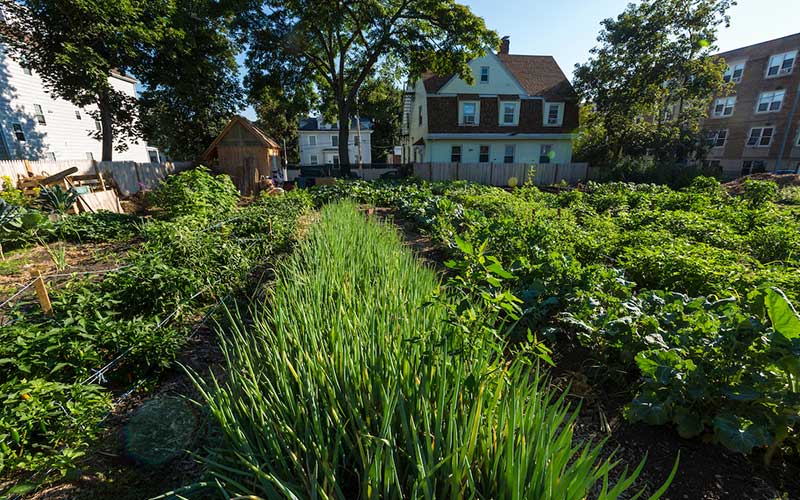
Urban farms like this one in Dorchester, Massachusetts, can boost the local economy, make healthy food more accessible, and serve as a community gathering place. Photo: EcoPhotography
When asked to picture a farm, few of us imagine a city block with a once-vacant lot bursting with greens or the rooftop of an office building covered in ripe tomato vines and squash blossoms.
But such urban images are a growing part of the modern farming landscape, as more and more cities across the United States recognize the role city farms can play in improving community health, boosting the local economy, and revitalizing the environment. What’s more, with many more people choosing to live in cities, urban farms will become critical resources in ensuring our metropolises are resilient and self-sufficient, especially as climate change impacts how and where we grow our food.
A Growing Trend
Urban agriculture comes in many shapes and sizes, from a rooftop farm to a community garden to an indoor window farm. When combined with traditional local agriculture, city farming provides a unique opportunity to build and strengthen a robust local food system. This is especially true here in New England, where interest in local food is booming, but easy and affordable access to it is still limited, especially for low-income urban residents.
Several cities here have already made it easier for urban farmers to operate within city limits. Boston, for example, has allowed farmers to grow commercial produce within the city since 2013, and a bill now making its way through the Massachusetts state legislature would create financial incentives for growing commercially in cities across the state.
More work must be done across New England to help the region fully realize the promise and potential of urban agriculture. That work begins with understanding its benefits and why, no matter where you live, you’ll want to pay attention to this growing trend.
Urban Agriculture Can Make Our Communities Healthier
Access to fresh, healthy food is a significant issue for many of us living in low-income neighborhoods. This is especially true in urban areas where residents must travel more than a mile to access a full-service grocery store. Too often, that lack of access means having to buy food from convenience stores or fast-food restaurants, which rarely have fresh fruits and vegetables on sale.
But city farms can make fresh, healthy food more accessible and affordable right where people live. A community garden lets families grow their own food, while a city farm can supply fruits and vegetables for local stores and farmers markets to sell. What’s more, just having a farm in a neighborhood creates a stronger sense of community and connection between growers and eaters by making it possible for residents to see where their food is grown (and by creating opportunities to volunteer or even work at the farm, too).
And, not all city farms have to be commercial to provide health benefits. Urban school gardens, for instance, produce food for public schools, leading to healthier lunch menus (and a great lesson for kids on where food comes from).
Urban Agriculture Can Boost the Local Economy
Urban farms can become a part of the community rather than simply exist within it – providing economic benefits both through their physical use of space and the role they play as job creators. For example, replacing a vacant lot that has fallen into disrepair with a vibrant city farm saves the city money on maintenance costs for that lot, while also removing a blight that can lower home values.
Many urban farms also provide jobs for local residents, hiring youth after school or during breaks and providing them with small stipends. This is a reliable way for students to build real-world skills and start earning their own income – which they, in turn, spend in the neighborhood.
Urban Agriculture Helps the Environment – Both Globally and Locally
It’s easy to forget that often the produce we buy at a grocery store travels hundreds or even thousands of miles before getting to shelves. The distance that food travels is directly related to fuel consumption and carbon emissions. Cutting that distance will reduce climate-damaging pollution, and locally sourced food can leave a much smaller carbon footprint.
But the benefits go beyond our global climate. The infusion of green space in an urban neighborhood can counter so-called heat-island effect, where temperatures in a dense city area can soar 20 to 50 degrees higher than in suburban neighborhoods. Turning asphalt lots into urban farms can help lower temperatures – which, in turn, will mean fewer spikes in heat-related health issues, with the added benefit of less energy needed for cooling systems.
Country Farm, City Farm: Better Together
There are many benefits and areas of efficiency in traditional commercial farms in more rural areas, so the goal of urban farms isn’t to replace them. However, we can learn how to utilize urban spaces better to take better advantage of them. Rather than paving over or leaving a vacant lot in poor shape, cities can encourage residents to transform these areas into something that is economically viable, and we can do that by considering policies that would incentivize aspiring farmers. As cities continue to grow, it is essential to consider all the many different aspects that would ensure our shared urban spaces can grow to their highest potential.
A version of this blog was originally published in November of 2017. It has been updated to reflect the current bill under consideration by the Massachusetts legislature.



